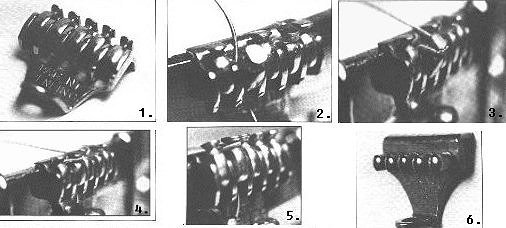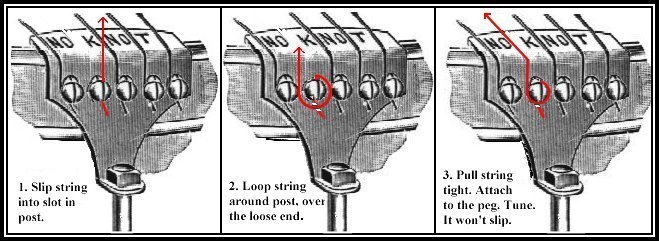
The No Knot tailpiece can be found on high grade banjos from the period around the turn of the century. They, along with other brands, were conceived to eliminate the annoying problem of tying a knot in the gut strings of the day--loop and ball end banjo strings are a comparatively modern adaptation. Most other, earlier tailpieces simply had holes, through which the string was passed.

Two versions of the No Knot are known, and it is the earlier of the two (photos 1-5) which this pictorial seeks to explain. The posts on the second style (photo 6) are not moveable and some confusion exists over their use, and will be covered later in the article. The first version generally has 5 cams--one for each string (photo 1). A string with no knot (hence the name) is passed down between the cam and the body (photo 2). It then loops around the top of the cam (photo 3) pulling it snug and preventing the end from slipping out (photos 4 and 5). The pressure is held by the tuner and the string will not come loose.
At least three versions of the markings on cammed No Knots are known, of which, most are imprinted "Patent Pending." A small number of cammed No Knots have had the designation "Patent, May 24, 1892" and the third version has no markings at all.
There are 4, 5, and 6 string versions of the non-cammed No Knot with at least 2 variations of the markings. Most have the imprint "No Knot, Pat. Nov 19, 1901." The one with the name on the top is earliest and has very rounded posts. Below are pictures showing how the non-cammed version works.

The strings can be clearly seen in this turn-of-the-century ad. The same method works for the competing Elite tailpiece.

Only 5 string, cammed No Knots have been seen as "stand alone" tailpieces, but the most unusual use of the cam mechanism was a marriage of the No Knot with the body of a Kershner Unique, a tailpiece which was not patented until 1914; both 4 and 5 string versions of this style have been seen.
Recently, a reproduction of the 1901 No Knot has come on the market. It can be distinguished from the originals in several ways. First, the metal is thinner, although only slightly, and less rigid, than the originals. Second, the name and date are stamped in a different font, which is also larger than on the originals. Third, the post are different. And finally, the new ones are very shiny, with a Phillips-head attachment bolt, although these last two features could change with time.
![]() Attention Webmasters: You are welcome to link to this article from your website, crediting the source, but you may not copy it and post it at your site. Thank you for your cooperation.
Attention Webmasters: You are welcome to link to this article from your website, crediting the source, but you may not copy it and post it at your site. Thank you for your cooperation.